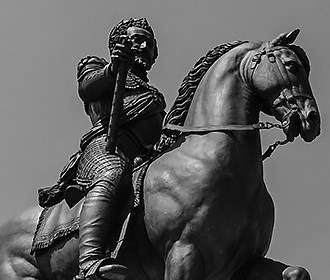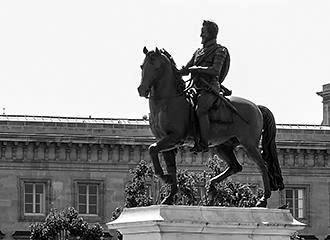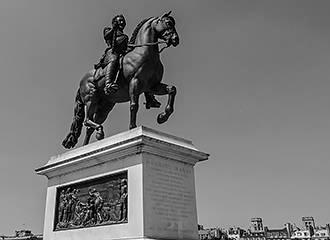Paris King Henri IV Equestrian Statue History
The Paris King Henri IV Equestrian statue is located in the middle of the Pont Neuf bridge and although the original statue dated from the 1600s, but today there is actually a replica in its place that was produced in the 1800s after the original was destroyed during the French Revolution.
A bit about King Henri IV
King Henri IV was known by many different names including King of France from 1589 through to 1610, the King of Navarre, le Bon Roi Henri, which translates in English to the Good King Henry, Henri The Great and the Vert Galant due to the many mistresses he had.
And even though he was not favoured within religious realms, he was a popular king for many and done much to improve Paris, including the construction of the Pont Neuf Bridge, which he named himself as the New Bridge, which travelled over the River Seine and met on the Ile de Cite island.
The Original Paris King Henri IV Equestrian Statue History
The construction of the Paris King Henri IV equestrian statue was the idea of his wife Marie de Medici and she commissioned Giambologna who was a pupil of Michelangelo to start on the bronze statue back in 1604.
However, after his death in 1608, this bronze equestrian statue was completed by the assistant of Giambologna, Pietro Tacca, and the completed bronze arrived in Paris in 1613, which was the very first royal equestrian monument in France.
But unfortunately, King Henri IV was assassinated in 1610, and therefore this was now going to be a monument specifically dedicated to him according to Marie de Medici, the Regent of France to their son, the future King Louis XIII.
The Queen then commissioned a large marble base to be produced and she entrusted the work of the pedestal to the sculptor Pierre Francqueville, who was a pupil of Giambologna whilst in Florence, although at the time he was living in Paris.
He made bas reliefs along with modelled captives that stood at the corners of the pedestal, and although the Paris King Henri IV equestrian statue was installed on the Ile de la Cite island in 1614, which was four years after the death of the king, it was only by 1618 that these captives were completed by the son in law of Francqueville, who was called Francesco Bordoni.
After this very first monument dedicated to a King of France was erected, others followed over time, along with other notable figures in the history of Paris, but then came the French revolution, and unfortunately numerous different statues, sculptures and other items were destroyed.
And yes, you have guessed already, this Paris King Henri IV equestrian statue was melted down during this time, yet the four Captives, as they are known, were spared of this fate due to the fact that they were classed as slender in design and paid tribute to a style of antiquities in France.
You may also be pleased to know that these four Captives sculptures are still in existence and are held within the fabulous Musee du Louvre Museum in the department of sculptures in France from the 17th and 18th centuries.
Paris King Henri IV Equestrian Statue History 1800s
However, the fact that you can still see an equestrian statue of King Henri IV today, means that there is a happy ending to the history of this Paris statue.
In fact, it was in the early part of the 1800s, after the Restoration, that a replica statue was constructed, and it was executed by the sculptor Francois Frederic Lemot, which was put in place in the same position on the Ile de la Cite island in 1818.
So if you do decide to visit this historical Paris monument called the Statue Equestre d'Henri IV, as it is spelt in French, this one from the early 1800s is what you can still see today, located in the same position where the Pont Neuf intersects on the Ile de la Cite in between the Place Dauphine and the Square du Vert Galant.
Transport options
Paris Metro lines 4, 7
Bus lines 21, 24, 27
Bus line 38
Bus line 47
Bus line 58
Bus line 69
Bus lines 70, 72, 74, 75
Bus lines 81, 85
Bus line 96
Night bus lines N12, N13, N14, N15, N16
Night bus lines N21, N22
RER Train lines B, C
Water bus service


